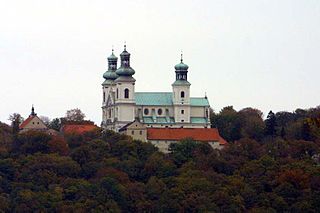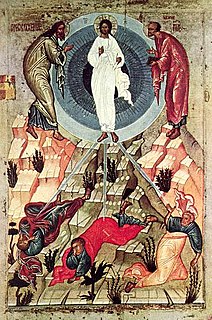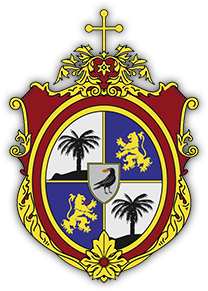Related Research Articles
A religious order is a lineage of communities and organizations of people who live in some way set apart from society in accordance with their specific religious devotion, usually characterized by the principles of its founder's religious practice. The order is composed of laypeople and, in some orders, clergy. Religious orders exist in many of the world's religions.

Augustinians are members of Christian religious orders that follow the Rule of Saint Augustine, written in about 400 AD by Augustine of Hippo. There are two distinct types of Augustinians in Catholic religious orders dating back to the 12th–13th centuries:

A hermit, or eremite, is a person who lives in seclusion. Hermits are a part of several sections of various religions and this concept has garnered significant attention and importance.

The Camaldolese monks and nuns are two different, but related, monastic communities that trace their lineage to the monastic movement begun by Saint Romuald.

The Gilbertine Order of Canons Regular was founded around 1130 by Saint Gilbert in Sempringham, Lincolnshire, where Gilbert was the parish priest. It was the only completely English religious order and came to an end in the 16th century at the time of the Dissolution of the Monasteries. Modest Gilbertine revivals have taken place in the late 20th and early 21st centuries on three continents.

Christian monasticism is the devotional practice of Christians who live ascetic and typically cloistered lives that are dedicated to Christian worship. It began to develop early in the history of the Christian Church, modeled upon scriptural examples and ideals, including those in the Old Testament, but not mandated as an institution in the scriptures. It has come to be regulated by religious rules and, in modern times, the Canon law of the respective Christian denominations that have forms of monastic living. Those living the monastic life are known by the generic terms monks (men) and nuns (women). The word monk originated from the Greek μοναχός, itself from μόνος meaning 'alone'.

The Order of Canons Regular of Prémontré, also known as the Premonstratensians, the Norbertines and, in Britain and Ireland, as the White Canons, is a religious order of Canons regular of the Catholic Church founded in Prémontré near Laon in 1120 by Norbert of Xanten, who later became Archbishop of Magdeburg. Premonstratensians are designated by O.Praem. following their name.

The Rule of Saint Augustine, written about the year 400, is a brief document divided into eight chapters and serves as an outline for religious life lived in community. It is the oldest monastic rule in the Western Church.

The Order of Saint Jerome or Hieronymites is a Catholic cloistered religious order and a common name for several congregations of hermit monks living according to the Rule of Saint Augustine, though the role principle of their lives is the 5th-century hermit and biblical scholar Saint Jerome.

Canons regular are canons in the Catholic Church who live in community under a rule and are generally organised into religious orders, differing from both secular canons and other forms of religious life, such as clerks regular, designated by a partly similar terminology.
Canoness is a member of a religious community of women living a simple life. Many communities observe the monastic Rule of St. Augustine. The name corresponds to the male equivalent, a canon. The origin and Rule are common to both. As with the canons, there are two types: canonesses regular, who follow the Augustinian Rule, and secular canonesses, who follow no monastic Rule of Life.
Anthonians applies to four Catholic Religious communities or Orders and a single Chaldean one, all under the patronage of St. Anthony the Hermit, father of monasticism, or professing to follow his rule.

The Abbey of Saint Victor, Paris, also known as Royal Abbey and School of Saint Victor, was an abbey near Paris, France. Its origins are connected to the decision of William of Champeaux, the Archdeacon of Paris, to retire to a small hermitage near Paris in 1108. He took on the life, vocation and observances of the Canons Regular, and his new community followed the Augustinian Rule.

Augustinian nuns are the most ancient and continuous segment of the Roman Catholic Augustinian religious order under the canons of contemporary historical method. The Augustinian nuns, named after Saint Augustine of Hippo, are several Roman Catholic enclosed monastic orders of women living according to a guide to religious life known as the Rule of St. Augustine. Prominent Augustinian nuns include Italian composer Vittoria Aleotti, Italian mystic St. Clare of Montefalco, German mystic Anne Catherine Emmerich and St. Rita of Cascia.

Lawrence Justinian is venerated as a saint by the Catholic Church. He was a canon regular who was appointed as a bishop and became the first Patriarch of Venice.

The Order of Saint Paul the First Hermit, known also simply as Pauline Fathers, is a monastic order of the Roman Catholic Church, founded in Hungary during the 13th century. Its post-nominal letters are O.S.P.P.E.
A religious institute is a type of institute of consecrated life in the Catholic Church where its members take religious vows and lead a life in community with fellow members. Religious institutes are one of the two types of institutes of consecrated life; the other is that of the secular institute, where its members are "living in the world".

Red Cloister is an Augustinian Priory, founded in 1367. It is located in the Sonian Forest, in south-eastern Brussels, Belgium. It was abolished in 1796. Today, it is administered from Auderghem, which is a commune of Brussels.
Ludovico Barbo, O.S.B. (1381–1443), also referred to as Luigi Barbo, was a significant figure in the movement to reform monastic life in northern Italy during the 15th century. Originally a canon of the community which became the Canons Regular of San Giorgio in Alga, he died a Benedictine abbot and Bishop of Treviso (1437–1443).

Origen de los frayles ermitaños de la Orden de San Augustin y su verdadera institucion antes del gran Concilio Lateranense is a 1618 work by the Augustinian scholar Juan Márquez, Royal preacher and Chair of Theology at the University of Salamanca. It contributed to a long-running debate within the Augustinian order as to whether the friars (hermits) or the canons were the older-established foundation. Márquez argued that the hermits were the more ancient establishment.